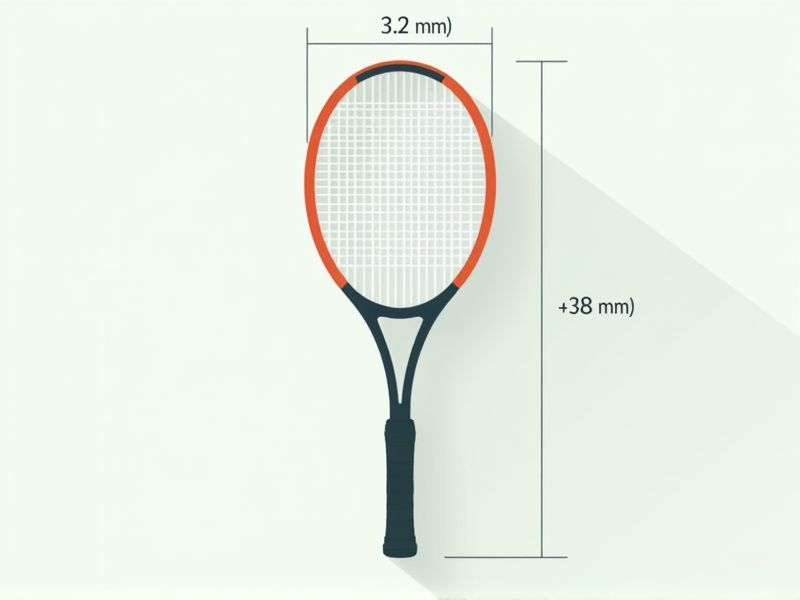
When choosing a tennis racket, understanding the standard dimensions can help you find the best fit for your game. Most adult tennis rackets are about 27 inches (68.58 cm) in length, which is the typical standard size, although some can range up to 29 inches for extra reach and power. The head size, which affects the hitting area and forgiveness, usually falls between 97 and 105 square inches (625-677 sq cm) for standard models. Ensuring the right grip size, commonly between 4 1/8 and 4 5/8 inches in circumference, will also make a big difference in comfort and control during play.
Overall Length
The overall length of a tennis racket typically ranges from 27 to 29 inches, with most standard adult rackets measuring 27 inches. A longer racket can provide additional reach and leverage, facilitating more power in serves and groundstrokes, while a shorter racket may offer enhanced maneuverability and control for net play. When selecting a racket, consider how the overall length affects your playing style and comfort, as it can significantly influence your performance on the court. Your choice should align with personal preferences and skill level to optimize your game.
Head Size
The head size of a tennis racket significantly influences performance and play style, ranging from 85 to 135 square inches. Rackets with larger head sizes, typically over 100 square inches, provide a larger sweet spot, making it easier to generate power and achieve forgiveness on off-center hits. Smaller head sizes, around 85-98 square inches, offer more control and precision, appealing to advanced players who prefer to dictate the pace of the game. When selecting a racket, consider how the head size aligns with your skill level and playing style to enhance your overall game experience.
Beam Width
The beam width of a tennis racket significantly influences its performance, with standard measurements ranging from 20mm to 30mm. A thinner beam, around 20mm, offers better control and feel, ideal for advanced players seeking precision in their game. Conversely, a wider beam, typically 28mm to 30mm, enhances power and stability, making it suitable for beginners and intermediate players. Understanding the impact of beam width can help you choose a racket that aligns with your playing style and skill level.
String Pattern
The string pattern of tennis rackets typically varies between dense and open configurations, affecting both power and spin. A standard 16x19 string pattern, for example, provides a good balance between control and the ability to generate spin, making it popular among intermediate and advanced players. In contrast, a 18x20 string pattern offers more precision and control, ideal for players who prioritize placement over power. When selecting your racket, consider how the string pattern aligns with your playing style to enhance your performance on the court.
Grip Size
The grip size of a tennis racket is crucial for optimal performance and comfort, with standard sizes ranging from 4 inches to 4 3/4 inches in diameter. Choosing the right grip size enhances your control and reduces the risk of injury, as a well-fitted grip allows for better maneuverability during play. You can determine your ideal grip size by measuring the distance from the tip of your ring finger to the second line in your palm, which typically correlates to a specific grip size. Using a properly sized grip not only improves stroke accuracy but also enhances your overall playing experience on the court.
Balance Point
The balance point of a tennis racket significantly impacts your performance, typically categorized between 320mm to 335mm. A racket with a head-heavy balance, above 330mm, provides more power and stability for aggressive players. Conversely, a head-light racket, below 320mm, allows for greater maneuverability and control, ideal for players who focus on quick exchanges at the net. Understanding your preferred balance point can enhance your gameplay and help you choose a racket that complements your style.
Frame Stiffness
Frame stiffness is a crucial factor in determining the performance of a tennis racket, influencing power and control during play. A stiffer frame, typically rated between 65-75 RA (Racket Assistance), provides increased energy transfer upon impact, resulting in greater ball speed. Conversely, a more flexible frame, usually around 50-60 RA, offers enhanced feel and comfort, ideal for players seeking precision and touch. Choosing the right frame stiffness for your style can significantly impact your game, allowing you to optimize both power and control.
Swing Weight
Swing weight, measured in kilograms per centimeter squared (kg*cm2), significantly influences your performance in tennis. This metric reflects how heavy a racket feels during swinging, impacting your power and control. Standard swing weights for adult rackets generally range from 290 to 320, with lower values favoring maneuverability and higher values providing stability. Choosing a racket with the right swing weight can enhance your timing and precision on the court.
Strung Weight
The standard strung weight of a tennis racket typically ranges from 9 to 11.5 ounces (255 to 325 grams), significantly impacting playability and performance. Rackets weighing between 10 to 10.5 ounces (285 to 300 grams) offer a balance of power and control, making them suitable for intermediate players. Heavier rackets, around 11 to 11.5 ounces (310 to 325 grams), provide enhanced stability and shock absorption, favored by advanced players who generate their own power. Understanding strung weight is essential for selecting a racket that complements your playing style and enhances your overall performance on the court.
Shaft Width
The standard width for a tennis racket shaft typically ranges from 20 to 23 millimeters, significantly impacting the racket's stability and power. A wider shaft often provides enhanced control and improved performance on the court, allowing for more accurate shots. For recreational players, choosing a shaft width within this range can boost confidence and consistency during play. You should consider your playing style when selecting a racket, as the shaft's dimensions can dramatically influence your overall game experience.
